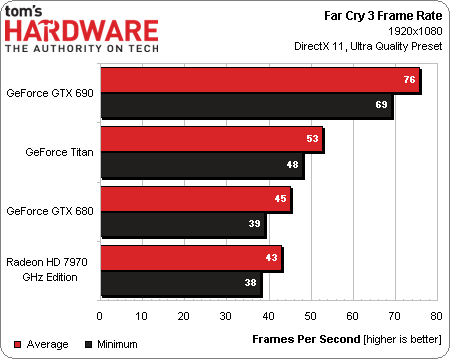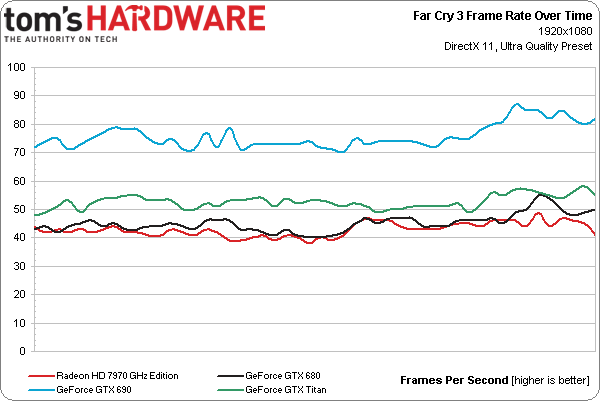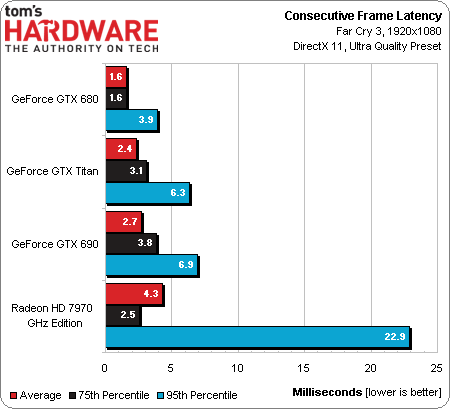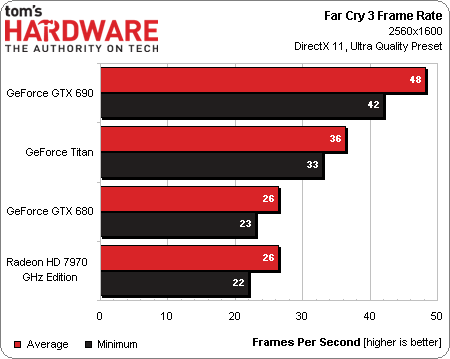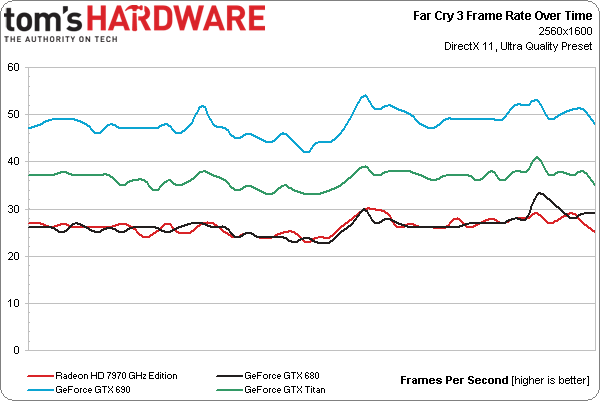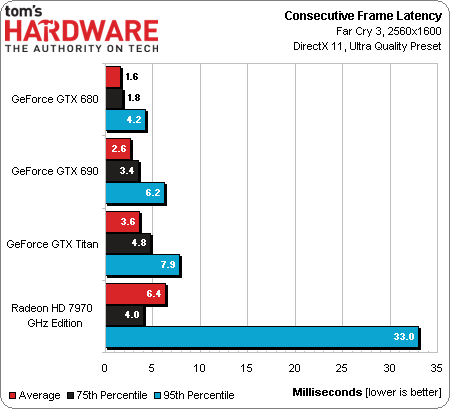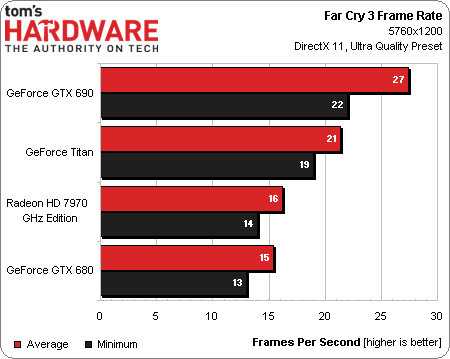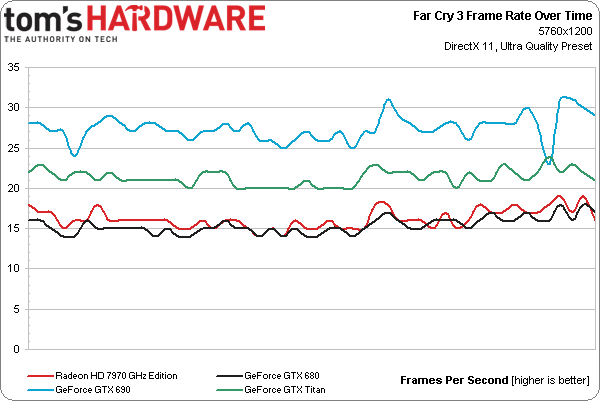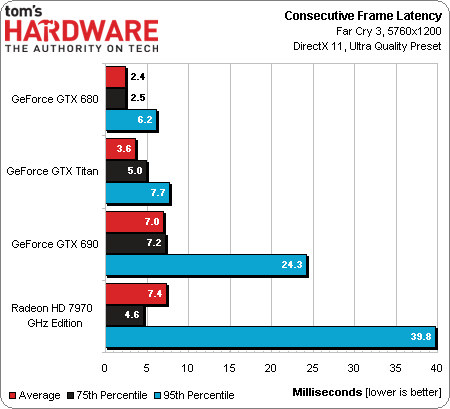Benchmarking GeForce GTX Titan 6 GB: Fast, Quiet, Consistent
We've already covered the features of Nvidia's GeForce GTX Titan, the $1,000 GK110-powered beast set to exist alongside GeForce GTX 690. Now it's time to benchmark the board in one-, two-, and three-way SLI. Is it better than four GK104s working together?
Results: Far Cry 3
Resolution: 1920x1080
Based on the Dunia Engine 2, Far Cry 3 is far more demanding than Borderlands 2. Even at 1920x1080, it pushes the minimum frame rates on AMD’s Radeon HD 7970 GHz Edition and Nvidia’s GeForce GTX 680 under 40. The averages aren’t much higher, either. Only the GeForce GTX 690 cuts through this combination of resolution and quality settings with great numbers. GeForce GTX Titan doesn’t do significantly better than the 680.
The extent of the 690’s victory (and Titan’s underwhelming advantage, given its price) is even better-illustrated by charting frame rate over time. GeForce GTX 680 and Radeon HD 7970 GHz Edition trade blows, though the 680 tends to be a bit quicker.
Here’s where latency starts to come into play. Whereas AMD claims to have improved the frame time latency of its driver in Borderlands 2, Skyrim, and Guild Wars 2, we haven’t seen any indication that Far Cry 3 has received similar treatment. It’s somewhat disturbing to see such a low 75th percentile number, an average that’s actually higher, and a 95th percentile result that shoots up to 20+ ms. Clearly, when latencies get bad on the 7970 GHz Edition, they get really bad.
Resolution: 2560x1600
Far Cry 3 continues punishing our high-end graphics cards, and the GeForce GTX 690 would at least appear to be the only board most folks would be comfortable gaming on at the Ultra preset. Titan’s performance is marginal, while the GeForce GTX 680 and Radeon HD 7970 GHz both average less than 30 FPS.
The separation (or lack of) between cards looks similar at 2560x1600 as it did at 1920x1080, only down about 20 FPS.
Get Tom's Hardware's best news and in-depth reviews, straight to your inbox.
All cards run into higher consecutive frame latency as their performance drops. The Radeon HD 7970 GHz Edition’s average latency doesn’t go up by much. But we can see that the 95th percentile number is more than 10 ms higher than it was at 1920x1080.
Now, here is one example of where GeForce GTX 690’s performance doesn’t appear to be accurately represented due to the point in the pipeline where Fraps takes its measurement. Average frame rates look good. The frame rate over time seems pretty normal. And the consecutive frame latency number appears remarkably low. However, playing through the game—a critical component of the evaluation, in our minds—uncovers a lot of stuttering. We’re not sure if the 2 GB of GDDR5 available to each GPU isn’t enough, or if Nvidia’s metering technology (which it hasn’t spent much time talking about yet, but is already public domain) isn’t handling Far Cry 3 well. Whatever the case, we assure you that this game isn’t fun to play on a 690 at 2560x1600 and up.
Resolution: 5760x1200
No single-card solution is able to give us good average frame rates at 5760x1200. Far Cry 3 is just begging for a little multi-GPU testing.
Uniformly sub-30 FPS results keep us from moving around quickly in this first-person shooter. That’s never conducive to a great experience, even if Far Cry 3 looks amazingly lush across three screens.
Average frame rates are more of an issue than consecutive frame latencies at 5760x1200, though AMD’s card continues running into severe worst-case latencies. Some evidence of what we ran into at 2560x1600 is quantifiable on the GeForce GTX 690, too.
Current page: Results: Far Cry 3
Prev Page Results: Borderlands 2 Next Page Results: Hitman: Absolution-
Novuake Pure marketing. At that price Nvidia is just pulling a huge stunt... Still an insane card.Reply -
whyso if you use an actual 7970 GE card that is sold on newegg, etc instead of the reference 7970 GE card that AMD gave (that you can't find anywhere) thermals and acoustics are different.Reply -
cknobman Seems like Titan is a flop (at least at $1000 price point).Reply
This card would only be compelling if offered in the ~$700 range.
As for compute? LOL looks like this card being a compute monster goes right out the window. Titan does not really even compete that well with a 7970 costing less than half. -
downhill911 If titan costs no more than 800USD, then really nice card to have since it does not, i call it a fail card, or hype card. Even my GTX 690 make more since and now you can have them for a really good price on ebay.Reply -
spookyman well I am glad I bought the 690GTX.Reply
Titan is nice but not impressive enough to go buy. -
hero1 jimbaladinFor $1000 that card sheath better be made out of platinum.Reply
Tell me about it! I think Nvidia shot itself on the foot with the pricing schim. I want AMD to come out with better drivers than current ones to put the 7970 at least 20% ahead of 680 and take all the sales from the greedy green. Sure it performs way better but that price is insane. I think 700-800 is the sweet spot but again it is rare, powerful beast and very consistent which is hard to find atm. -
raxman "We did bring these issues up with Nvidia, and were told that they all stem from its driver. Fortunately, that means we should see fixes soon." I suspect their fix will be "Use CUDA".Reply
Nvidia has really dropped the ball on OpenCL. They don't support OpenCL 1.2, they make it difficult to find all their OpenCL examples. Their link for OpenCL is not easy to find. However their OpenCL 1.1 driver is quite good for Fermi and for the 680 and 690 despite what people say. But if the Titan has troubles it looks like they will be giving up on the driver now as well or purposely crippling it (I can't imagine they did not think to test some OpenCL benchmarks which every review site uses). Nvidia does not care about OpenCL Nvidia users like myself anymore. I wish there more people influential like Linus Torvalds that told Nvidia where to go.
